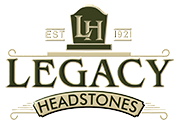Having a place to visit deceased family members and friends is important to anyone who has experienced death firsthand. These places provide a sense of comfort and closure that help us mourn and move on with time. However, being blind or even visually impaired may make it more difficult to visit or locate a loved one's grave without a certain system of identification. There are many ways of personalizing a gravestone in the modern world, and braille is quickly becoming a popular option for the blind and individuals that have blind family members. There are dozens of conditions and diseases that can cause blindness or visual impairment, but that doesn't mean that individuals with low vision should be restricted from visiting and honoring the deceased. In this article, we explain what braille headstones are, so you can better understand this rising trend and make an informed decision regarding your own end-of-life preferences.
What Is Braille?
Most people believe that braille is a language, but it is actually a system or raised dots that can be read with the fingers of people who are blind or visually impaired. Braille can be read with the eyes by someone who is not blind or does not have low vision, and it is used throughout the world in many native languages. This system of raised dots provides a means of literacy for all, despite vision impairment or the ability to perform everyday activities.
Before braille was invented, blind students were expected to read books that featured raised print. These formative books were difficult to produce and read, which made one student at the National Institute for Blind Youth in Paris yearn for a wider expanse of reading materials. That student's name was Louis Braille, who was born in 1809. While attending the institute, Braille experimented with an alphabet that could be read with just the fingertips. He adapted the tactile code known as "night writing" that was developed by Charles Barbier and used to send military messages. Sonography, as it is known today, was the precursor of braille. This new system consisted of symbols that were formed within units of space known as braille cells. Each cell can be used to represent a letter, number, punctuation mark, or a whole word.
What Is a Braille Headstone?
Many plaques and memorial markers feature both written letters and numerals as well as braille to accommodate people of varying abilities. Even if you aren't blind or visually impaired, it is possible to add a braille inscription to the headstone of your choice. Raised braille markings will make it more convenient for the blind or visitors with low vision to visit you or a loved one. At the final resting place of Helen Keller and elsewhere, you can find commemorative plaques that have her name in raised braille. No matter what material you use for the inscription, it is important that the braille message accurately represents the tactile message. Routed-out braille consists of creating cavities and leaving raised, rounded dots. Raster braille is the preferred process for producing signage, because it can be used on a variety of materials, such as acrylic, aluminum, brass, laminate, plastic, steel, wood, and much more. No matter which material you use, an engraving professional will be able to accurately and carefully transcribe your message.
If you have any questions about braille headstones or this article, please contact Legacy Headstones today for more information or further assistance.
